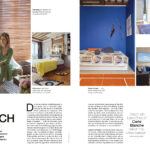L’Orient Le Jour, August 28, 2017
by Colette Khalaf
Once upon a time there was a pea-colored bomb
Between Andersen’s tales and the wars ravaging the Middle East, Sara Badr Schmidt finds her own connection by linking, deploying luminous and unreal spaces without borders.
Once upon a time there was a young girl whose life revolved around art (studies in graphic design and successful completion of a course in Paris). Once upon a time there was this same young girl, born into a culturally mixed family and who never made the difference between the borders that would separate men. Once upon a time there was a young girl wounded by the war, but who wanted to close this page and leave the country to embrace new, wider and calmer horizons.
She was a “suitcase” girl as she likes to define herself. Since then, this girl has settled in France, and she has become an artist and a mother. Caught up by her former ghosts, Sara Badr Schmidt travels the world, exhibits, installs her works and above all sends a clear and gentle message. Pascal Bruckner describes his work as a “committed allegory”. The starting point of her recent work installed in Agial is a project that she has been creating for more than ten years. “I work on the concept of borders because I find that it is the problem that plagues our century”. Borderless, the title of this project, even reaches the Chinese wall, exhibits in Venice and Milan, and returns to Lebanon, where the artist has turned her camera towards the azure-colored space above the Lebanese-Israeli border. The same sky then appears with nuanced but identical colors, with a few layers of clouds that fray here and there. Those same clouds that got lost one day and rained fire and iron. On light boxes, she transposes these bits of sky and adds the same word to them, like a common denominator: “Sawa” (together) to subsequently define the sky of rue Saint-Nicolas, the southern suburbs, Bourj Hammoud, Mazraa, Clémenceau or the Beirut port sector. Six regions with different identities where the sky captured at the same time turns out to be the same everywhere.
Tame the Demons
The second event at the base of this installation is the attack on Charlie Hebdo which caused fears in the minds of her children. “All the demons suddenly resurfaced”, says the artist, “how to tame them, domesticate them? asks Sara Badr Schmidt. Simply by arming oneself with art and poetic language to express the unsaid and the horrors. The artist who surfs between graphic design, visual arts and painting, screen printing or typography, likes to probe techniques and translate them in her own way. It all depends on the message to be conveyed. It’s not a political message, but it’s certainly tough and realistic just like in children’s stories. “Little Red Riding Hood” or “Little Thumb” were they not, under a fictitious and unreal appearance, imbued with a very real violence?
On a carpet woven in Nepal and dyed with natural pigments, Sara Badr Schmidt places a bed where a little girl is sleeping. She decided to face fate and harsh reality by sleeping on a pile of stacked mattresses just like “The Princess with the Pea” from the famous Danish tale of the same name. But unlike the princess, she will put the box spring as a shelter above her head to continue to fulfill her childhood dreams. On this base, the green pea is a big pea-colored bomb and hangs like a threatening Damocles sword.
“Once upon a time there was a pea” is an installation that juxtaposes and intertwines different places, eras and political contexts. Everything revolves around a question: how can different ethnic or religious communities cohabit? More than a question, it is the echo of the same cry arising from a deep concern that is spreading across the planet. The colors in which this installation is bathed are soothing, despite the violence described therein, because the artist’s message is intended to be non-torturing. There are these almost transparent azure hues, but even in the video where a flock of birds appear in regular formations, these spots seem to evoke warplanes. In these totally different and completely foreign worlds, between Andersen’s tales and the wars ravaging the Middle East, Sara Badr Schmidt finds her own connection by linking them, deploying luminous and unreal spaces without borders. Nothing is imposed. Everyone can read it to their liking.

